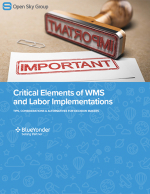Workforce Management Software: Taking the Pain out of Staffing Your Warehouse
In this paper, we cover the forces impacting the warehouse workforce today, how automation is affecting that workforce, and then we’ll dig into the tool of workforce management software to help you understand what it can offer your operations, and, most importantly, your workforce.
Workforce Management Software - What You Need To Know That Can Help You Efficiently Staff and Meet Demand
Your workforce is one of your greatest assets today. The demand and pressure around the retention of that warehouse workforce are becoming greater.
Particularly in the last three to five years, many of our clients have seen a dramatic shift in their warehouse labor.
How do you retain these workers and what can you really find that will help?
There are many tools, platforms, and capabilities to help relieve some of that pain and pressure. How ready are you internally as an organization to provide some of these tools to your warehouse workforce?
Is Automation The Answer? Does It Offer What Managers Need?
- Wages are going up: On average, wages increased by 10% between 2013 – 2017 and that’s much higher than the inflation rate across that same time period. We’re seeing more distribution centers move back into large metropolitan areas which increase wages and can make it more difficult to staff. What affects your bottom line the most? Human capital does, and a huge portion of your budget revolves around human capital. How can you leverage software to reduce the expenses of human capital and effectively manage your workforce?
- Demand is going up: Its basic economics, supply, and demand. Over the last two years, we’ve seen an increase of about a half-million workers in the supply chain, especially the warehousing industry. Brick and mortar are disappearing but concrete and racking aren’t disappearing because people are still buying things; they’re just getting it from a warehouse instead of a store. Warehouse workers are in short supply – thus the cost goes up.
- Automation could solve a few challenges: We know automation is going to help – it will reduce the number of workers needed eventually. What automation is doing currently is making us more efficient. We’re strictly trying to keep up right now. And the effect? While automation is simplifying the jobs, it’s not replacing the workers. Automation is changing something else for us all. It’s creating a huge shift in who’s able to manage operations because a facility isn’t just humans anymore; it’s automation and the humans that work with this automation.
Download this paper and discover how the forces are impacting the warehouse workforce today, and how automation is affecting that workforce.
Log in to download this paper.
What’s Related
Related Companies
Open Sky Group
Related Topics
Warehouse Management
AutomationOpen Sky GroupWarehouse ManagementWarehouse|DCWorkforce Management Software
All topics
News





What You Need to Consider for a Software-as-a-Service Warehouse Management System
What every supply chain organization needs to know about SaaS to make an informed decision on their next WMS deployment.
How Modern Logistics Companies Turn COVID Chaos into Long-Term Business Efficiency
Golf and How to Avoid Shanking Your Next Warehouse Management System Project
Panasonic to Buy U.S. Supply-Chain Software Firm Blue Yonder for $7.1 Billion
Labor Management Systems Solutions Increasingly Important Even With the Move to More Autom...
More News
Resources

2021 State of Supply Chain Execution Report
New research from Reuters Events Supply Chain in Partnership with Blue Yonder reveals the priority strategies and investments for supply chain execution and risk management within ...

Critical Elements of Warehouse Management Systems & Labor Implementations
This white paper explores the critical elements of warehouse management systems and labor management systems implementations, from setting expectations to ensuring the final instal...

5 Tips for Successful Warehouse Management System Implementations
This whitepaper, based on years of successful WMS implementations, offers tips for approaching, navigating and successfully completing your Warehouse Management Systems project.
More Resources
Favorites

How Does IKEA’s Inventory Management Supply Chain Strategy Really Work?
Each IKEA store is huge and holds more than 9,500 products! How in the world does IKEA offer so...

Starbucks as an Example of the Value Chain Model
The concept of value chain helps to understand and segregate the useful (which help in gaining a competitive...

7 Principles of Supply Chain Management Explained
Would you like to understand supply chain management concepts but don't have time to study from a textbook?...

Is Apple’s Supply Chain Really the No. 1? A Case Study
How Complex is Apple's Supply Chain? Some people in the blogosphere said that Apple's Supply Chain is not...

